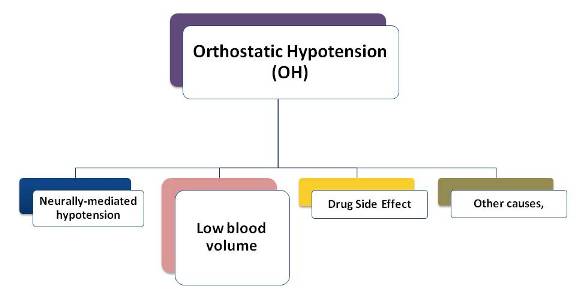Orthostatic Hypotension from Low Blood Volume
Orthostatic Hypotension (OH) means the blood pressure goes down when the person stands up and the person has orthostatic symptoms, such as dizziness, lightheadedness, changes in vision, and/or weakness.
Keeping blood pressure normal when we stand up depends on the amount of blood we have in our body. There has to be enough blood getting back to the heart so that it can pump blood back out to the head and body.
Being low on fluids can cause orthostatic hypotension (drop in blood pressure). It can also make the orthostatic symptoms even worse if a person already has an orthostatic problem.
In medical articles or material, a low volume of blood is referred to as "volume depletion". 1

What causes low blood volume or 'volume depletion'?
Loss of fluids - or loss of blood volume.
It could be volume depletion or dehydration from not drinking enough fluids. It also could be an imbalance in fluids. An imbalance means a person is losing more fluids than they take in. Fluids are lost with vomiting, diarrhea, fever, sweating a lot, and urinating a lot from drugs like diuretics. Conditions due to high outside temperatures like heat exhaustion and heat stroke have dehydration.
Loss of blood.
This is usually from bleeding. Bleeding loses both fluids in blood plasma and the red blood cells. It is measured by the hematocrit. A low number of red blood cells is called anemia. Red blood cells are critical because they carry oxygen from the lungs to the rest of the body and the cells. If the blood loss is big enough, there is a decrease in the number of cells that can carry oxygen. The cells do not get as much oxygen as they need to function. The symptoms of anemia are weakness, shortness of breath and chest pain.2
What happens to the pulse when there is this type of orthostatic low blood pressure?
When the only cause of the orthostatic hypotension (OH) is not enough blood volume, the pulse might actually increase. It's the body's way of trying to get the blood to the head and vital organs.
How is it managed?
Orthostatic hypotension (OH) caused by loss of fluids or blood is treated by replacing the volume (fluids). If there is a lot of fluid loss with vomiting or diarrhea, it is better to replace the fluids with liquids that have some electrolytes (like sodium and potassium). Commercial products would be Pedialyte® or products like Gatorade. You could also use water or tea plus extra salt.
For blood loss: If the amount of blood lost is not extensive, the fluid needs to be replaced and the body will make new blood cells. If the blood loss is significant, the person may need to receive red blood as a transfusion.
 Orthostatic Hypotension (OH):
Orthostatic Hypotension (OH):What is OH?
Criteria to diagnose OH
What is NMH?
OH due to low blood volume
OH due to drugs & other causes
Next Topics To Review
Causes of OI
Deconditioning
Getting Medical Care
Taking Care - Everyday Self-Care
References
- Moya, Guidelines for the diagnosis and management of syncope (version 2009). European Heart Journal (2009); 30: 2631-2671. Abstract. Article PDF.
- Freeman, Roy. Neurogenic orthostatic hypotension.NEJM 2008;358(6):615-624. Abstract
- Figueroa JJ, Basford JR, Low PA. Preventing and treating orthostatic hypotension: As easy as A, B, C. Cleve Clin J Med. 2010 May;77(5):298-306. Abstract. Article PDF.
- Wedro, Benjamin, Stoppler, Mellissa. Orthostatic hypotension. MedicineNet. Last accessed: June 24, 2012. Article"
- Brignole, M. The syndromes of orthostatic intolerance. E-journal of Cardiology Practice. 2007: 6(5). Access. http://www.escardio.org/communities/councils/ccp/e-journal/volume6/Pages/vol6n5.aspx
- Medow MS, Stewart JM, Sanyal S, Mumtaz A, Stca D and Frishman WH. Pathophysiology, Diagnosis, and Treatment of Orthostatic Hypotension and Vasovagal Syncope. Cardiology in Review 2008;16(1):4-20. Abstract.
- Winkelman, Chris RN, PhD, CCRN ACNP. Bed Rest in Health and Critical Illness: A Body Systems Approach. AACN Advanced Critical Care: 2009; 20(3); 254-266. Abstract.
- Brignole M. Diagnosis and Treatment of Syncope. Heart 2007: 93; 130-136. Article PDF
- Sukul D, Chelimsky TC, Chelimsky G. Pediatric autonomic testing: retrospective review of a large series.Clin Pediatr (Phila). 2012 Jan;51(1):17-22. doi: 10.1177/0009922811415102. Epub 2011 Aug 25. Abstract.
Author: Kay E. Jewell, MD
Page Last Updated: September 9, 2012
